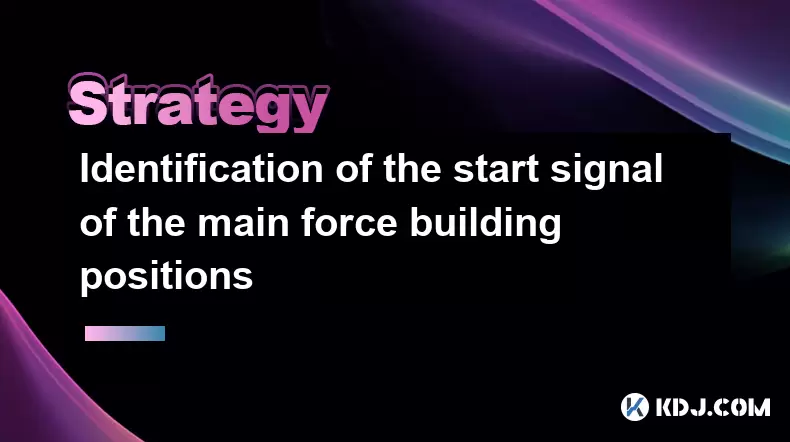-
 bitcoin
bitcoin $122288.232522 USD
0.16% -
 ethereum
ethereum $4480.662914 USD
-0.22% -
 xrp
xrp $2.962747 USD
-2.32% -
 tether
tether $1.000120 USD
-0.05% -
 bnb
bnb $1145.654223 USD
-2.07% -
 solana
solana $227.105217 USD
-1.67% -
 usd-coin
usd-coin $0.999548 USD
-0.02% -
 dogecoin
dogecoin $0.250875 USD
-2.04% -
 tron
tron $0.340654 USD
-0.49% -
 cardano
cardano $0.837968 USD
-2.52% -
 hyperliquid
hyperliquid $48.960449 USD
0.06% -
 chainlink
chainlink $22.049280 USD
-1.33% -
 ethena-usde
ethena-usde $1.000404 USD
0.02% -
 sui
sui $3.586212 USD
0.20% -
 avalanche
avalanche $29.894916 USD
-4.18%
Identification of the start signal of the main force building positions
The start signal of main force building positions in crypto trading can be identified through volume spikes, on-chain data, and sentiment analysis, giving traders an early advantage.
Jun 02, 2025 at 10:22 am

Understanding the Concept of Main Force Building Positions
In the world of cryptocurrency trading, the term 'main force' often refers to large institutional investors or whales who have the capacity to significantly influence market movements. The start signal of the main force building positions is a crucial concept for traders to grasp, as it indicates the beginning of a period where these major players are accumulating assets, often in preparation for a significant price movement. Identifying this signal can provide traders with an early advantage, allowing them to position themselves favorably before the broader market catches on.
Key Indicators of Main Force Position Building
Several technical and on-chain indicators can help traders identify when the main force is starting to build positions. Volume spikes are one of the most telling signs. When the trading volume suddenly increases without a corresponding change in price, it often suggests that large investors are entering the market. Another important indicator is on-chain transaction data, which can reveal large transfers to and from exchanges. A significant increase in the number of large transactions moving to cold storage or other long-term holding wallets may indicate that the main force is accumulating.
Analyzing Price Action and Order Book Data
Price action analysis is another vital tool for spotting the start signal of the main force building positions. Unusual price movements, such as sudden price stabilization after a period of volatility, can signal that large investors are entering the market to establish a base. Additionally, examining the order book can provide insights. A thickening of the order book, particularly at certain price levels, may indicate that the main force is setting up buy walls to control the price.
Utilizing On-Chain Metrics for Confirmation
On-chain metrics offer a deeper level of analysis that can confirm the start signal of the main force building positions. Active addresses and transaction volume can show increased activity, suggesting that more investors are engaging with the asset. Metrics like MVRV (Market Value to Realized Value) ratio can also be useful. When the MVRV ratio is low, it may indicate that the asset is undervalued and ripe for accumulation by the main force.
Employing Sentiment Analysis Tools
Sentiment analysis tools can also play a role in identifying the start signal of the main force building positions. Social media sentiment and news analysis can provide insights into the broader market sentiment. A sudden shift in sentiment from negative to positive, or a surge in positive news about the asset, can be a precursor to the main force beginning to build positions. Tools like sentiment score calculators and natural language processing algorithms can help traders monitor these shifts in real-time.
Practical Steps to Identify the Start Signal
To effectively identify the start signal of the main force building positions, traders can follow these practical steps:
- Monitor Trading Volume: Use trading platforms and charting tools to keep an eye on volume spikes. Set alerts for unusual volume increases that are not accompanied by significant price changes.
- Analyze On-Chain Data: Utilize on-chain analytics platforms to track large transactions and wallet movements. Look for patterns of accumulation, such as large amounts of cryptocurrency being moved to cold storage.
- Study Price Action: Regularly review price charts to identify unusual price stabilization or other patterns that may indicate the main force is entering the market. Use technical analysis tools to confirm these observations.
- Examine the Order Book: Access the order book on your trading platform and look for thickening at specific price levels. This can be a sign of buy walls being established by the main force.
- Track On-Chain Metrics: Use on-chain analytics tools to monitor metrics like active addresses, transaction volume, and the MVRV ratio. Look for trends that suggest increased accumulation activity.
- Leverage Sentiment Analysis: Employ sentiment analysis tools to track changes in social media sentiment and news related to the cryptocurrency. Set up alerts for significant shifts in sentiment that could indicate the start of main force position building.
FAQ
Q: Can retail traders effectively compete with the main force in building positions?A: While retail traders may not have the same financial resources as the main force, they can still compete by leveraging technical analysis, on-chain data, and sentiment analysis to identify early signals and position themselves accordingly. The key is to stay informed and act quickly when opportunities arise.
Q: How can traders differentiate between genuine main force activity and market manipulation?A: Distinguishing between genuine main force activity and market manipulation can be challenging. Traders should look for consistent patterns across multiple indicators, such as volume spikes, on-chain data, and price action. If these indicators align, it increases the likelihood that the activity is genuine. Additionally, staying informed about regulatory news and market trends can help traders spot potential manipulation.
Q: Are there specific cryptocurrencies that are more likely to be targeted by the main force for position building?A: The main force may target any cryptocurrency, but they often focus on assets with high liquidity and potential for significant price movements. Cryptocurrencies like Bitcoin and Ethereum are frequent targets due to their market dominance and liquidity. However, smaller altcoins with strong fundamentals and growing adoption may also attract the main force.
Q: How long does the main force typically take to build positions?A: The duration of main force position building can vary widely depending on market conditions and the specific strategy of the investors involved. It can range from a few days to several weeks or even months. Traders should monitor the indicators mentioned above continuously to stay updated on the progress of position building.
Disclaimer:info@kdj.com
The information provided is not trading advice. kdj.com does not assume any responsibility for any investments made based on the information provided in this article. Cryptocurrencies are highly volatile and it is highly recommended that you invest with caution after thorough research!
If you believe that the content used on this website infringes your copyright, please contact us immediately (info@kdj.com) and we will delete it promptly.
- BlockDAG, DOGE, HYPE Sponsorship: Crypto Trends Shaping 2025
- 2025-10-01 00:25:13
- Deutsche Börse and Circle: A StableCoin Adoption Powerhouse in Europe
- 2025-10-01 00:25:13
- BlockDAG's Presale Buzz: Is It the Crypto to Watch in October 2025?
- 2025-10-01 00:30:13
- Bitcoin, Crypto, and IQ: When Genius Meets Digital Gold?
- 2025-10-01 00:30:13
- Stablecoins, American Innovation, and Wallet Tokens: The Next Frontier
- 2025-10-01 00:35:12
- NBU, Coins, and Crypto in Ukraine: A New Yorker's Take
- 2025-10-01 00:45:14
Related knowledge

Practical parameter settings for a Bitcoin multi-timeframe moving average system
Sep 18,2025 at 10:54pm
Optimizing Timeframe Combinations for Bitcoin Trading1. Selecting appropriate timeframes is crucial when building a multi-timeframe moving average sys...

How can I filter out false breakouts in Dogecoin high-frequency trading?
Sep 22,2025 at 01:00am
Understanding False Breakouts in Dogecoin Trading1. A false breakout occurs when Dogecoin's price appears to move beyond a defined support or resistan...

Techniques for identifying tops and bottoms in the Bitcoin on-chain NVT model
Sep 20,2025 at 07:54pm
Understanding the NVT Model in Bitcoin Analysis1. The Network Value to Transactions (NVT) ratio is often described as the 'P/E ratio' of the cryptocur...

What does the surge in open interest in Bitcoincoin futures mean?
Sep 20,2025 at 11:18pm
Understanding the Surge in Dogecoin Futures Open Interest1. A surge in open interest within Dogecoin futures indicates a growing number of active cont...

How can I use the Ethereum USDT premium to gauge market sentiment?
Sep 18,2025 at 11:55pm
Understanding the Ethereum USDT Premium1. The Ethereum USDT premium refers to the price difference between USDT (Tether) traded on Ethereum-based plat...

What should I do if Ethereum staking yields decline?
Sep 20,2025 at 06:18am
Understanding the Causes Behind Declining Ethereum Staking Yields1. The Ethereum network transitioned to a proof-of-stake consensus mechanism with the...

Practical parameter settings for a Bitcoin multi-timeframe moving average system
Sep 18,2025 at 10:54pm
Optimizing Timeframe Combinations for Bitcoin Trading1. Selecting appropriate timeframes is crucial when building a multi-timeframe moving average sys...

How can I filter out false breakouts in Dogecoin high-frequency trading?
Sep 22,2025 at 01:00am
Understanding False Breakouts in Dogecoin Trading1. A false breakout occurs when Dogecoin's price appears to move beyond a defined support or resistan...

Techniques for identifying tops and bottoms in the Bitcoin on-chain NVT model
Sep 20,2025 at 07:54pm
Understanding the NVT Model in Bitcoin Analysis1. The Network Value to Transactions (NVT) ratio is often described as the 'P/E ratio' of the cryptocur...

What does the surge in open interest in Bitcoincoin futures mean?
Sep 20,2025 at 11:18pm
Understanding the Surge in Dogecoin Futures Open Interest1. A surge in open interest within Dogecoin futures indicates a growing number of active cont...

How can I use the Ethereum USDT premium to gauge market sentiment?
Sep 18,2025 at 11:55pm
Understanding the Ethereum USDT Premium1. The Ethereum USDT premium refers to the price difference between USDT (Tether) traded on Ethereum-based plat...

What should I do if Ethereum staking yields decline?
Sep 20,2025 at 06:18am
Understanding the Causes Behind Declining Ethereum Staking Yields1. The Ethereum network transitioned to a proof-of-stake consensus mechanism with the...
See all articles










































































